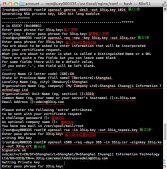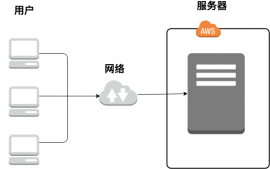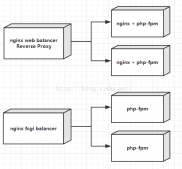其实本人比较喜欢nginx跑静态和做负载反向代理,动态php还是交给apache处理比较稳定,jsp就交给tomcat、resin或jboss。nginx跑静态的能力是无与伦比的,是目前web服务器里最强的。nginx和apache、tomcat、resin的动静分离配置其实很简单,就几句配置,稳定性也非常好。
1、nginx和apache的动静分离配置:
把下面配置放到nginx配置文件相应的server { }里面,如果使用其他端口号,改一下就行:
#所有php的动态页面均交由apache处理
|
1
2
3
4
5
6
|
location ~ \.(php)?$ {proxy_set_header Host $host;proxy_set_header X-Real-IP $remote_addr;proxy_set_header X-Forwarded-For $proxy_add_x_forwarded_for;proxy_pass http://127.0.0.1:88;} |
#所有静态文件由nginx直接读取不经过apache
|
1
2
3
4
|
location ~ .*\.(htm|html|gif|jpg|jpeg|png|bmp|swf|ioc|rar|zip|txt|flv|mid|doc|ppt|pdf|xls|mp3|wma)${ expires 15d; }location ~ .*\.(js|css)?${ expires 1h; } |
如果之前设置了FastCGI的,把下面的配置注释掉:
|
1
2
3
4
5
6
7
8
|
# pass the PHP scripts to FastCGI server listening on 127.0.0.1:9000##location ~ \.php$ {# root /var/www/html;# fastcgi_pass 127.0.0.1:9000;# fastcgi_index index.php;# include fastcgi.conf;#} |
重启nginx就生效,如图所示,标头显示nginx,phpinfo里面显示是apache,说明动静分离生效。

2.niginx和tomcat的动静分离配置:
#主配置文件配置
|
1
|
[root@localhost ~]# vi /usr/local/nginx/conf/nginx.conf |
|
1
2
3
4
5
6
7
8
9
10
11
12
13
14
15
16
17
18
19
20
21
22
23
24
25
26
27
28
29
30
31
32
33
34
35
36
37
38
39
40
41
42
43
44
45
46
47
48
49
50
51
52
53
54
55
56
57
58
59
60
61
62
63
|
user nginx;worker_processes 1;error_log logs/error.log;pid logs/nginx.pid;events { worker_connections 1024;}http { include mime.types; default_type application/octet-stream; #日志格式定义 log_format main '$remote_addr - $remote_user[$time_local] "$request" ' '$status $body_bytes_sent"$http_referer" ' '"$http_user_agent" "$http_x_forwarded_for"'; access_log logs/access.log main; sendfile on; keepalive_timeout 65; #gzip压缩功能设置 gzip on; gzip_min_length 1k; gzip_buffers 4 16k; gzip_http_version 1.0; gzip_comp_level 2; gzip_types text/plain application/x-javascripttext/css application/xml; gzip_vary on; server { listen 80; server_name www.test.com; location / { #jsp网站程序根目录,一般nginx与tomcat在同一个目录 root /usr/local/tomcat/webapps/ROOT; index index.html index.jsp index.html; } location ~ .*.jsp$ { index index.jsp; proxy_pass http://127.0.0.1:8080; #来自jsp请求交给tomcat处理 proxy_redirect off; proxy_set_header Host $host; #后端的Web服务器可以通过X-Forwarded-For获取用户真实IP proxy_set_header X-Real-IP $remote_addr; proxy_set_header X-Forwarded-For $proxy_add_x_forwarded_for; client_max_body_size 10m; #允许客户端请求的最大单文件字节数 client_body_buffer_size 128k; #缓冲区代理缓冲用户端请求的最大字节数 proxy_connect_timeout 90; #nginx跟后端服务器连接超时时间(代理连接超时) proxy_read_timeout 90; #连接成功后,后端服务器响应时间(代理接收超时) proxy_buffer_size 4k; #设置代理服务器(nginx)保存用户头信息的缓冲区大小 proxy_buffers 6 32k; #proxy_buffers缓冲区,网页平均在32k以下的话,这样设置 proxy_busy_buffers_size 64k;#高负荷下缓冲大小(proxy_buffers*2) proxy_temp_file_write_size 64k; #设定缓存文件夹大小,大于这个值,将从upstream服务器传 } location ~ .*\.(gif|jpg|png|bmp|swf)$ #由nginx处理静态页面 { expires 30d; #使用expires缓存模块,缓存到客户端30天 } location ~ .*\.( jsp|js|css)?$ { expires 1d; } error_page 404 /404.html; #错误页面 error_page 500 502 503 504 /50x.html; location = /50x.html { root html; } } |
#编写nginx启动、停止、重启等SysV管理脚本,方便使用
|
1
|
[root@localhost ~]# vi /etc/init.d/nginx |
|
1
2
3
4
5
6
7
8
9
10
11
12
13
14
15
16
17
18
19
20
21
22
23
24
25
26
|
#!/bin/bash# chkconfig: 345 99 20# description: Nginx servicecontrol scriptPROG="/usr/local/nginx/sbin/nginx"PIDF="/usr/local/nginx/logs/nginx.pid"case "$1" instart)$PROGecho "Nginx servicestart success.";;stop)kill -s QUIT $(cat $PIDF)echo "Nginx service stopsuccess.";;restart)$0 stop$0 start;;reload)kill -s HUP $(cat $PIDF)echo"reload Nginx configsuccess.";;*)echo "Usage: $0{start|stop|restart|reload}"exit 1esac |
|
1
2
3
4
|
[root@localhost ~]# chmod +x /etc/init.d/nginx[root@localhost ~]# service nginx restart[root@localhost ~]# chkconfig --add nginx[root@localhost ~]# chkconfig nginx on |
















